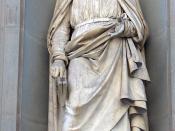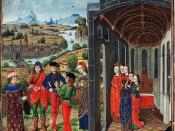There are three basic genres in literature: drama, fiction, and poetry. All three categories can use comedy. Comedy again can be divided into high and low comedy. High comedy is comedy that is appealing to, and reflecting the life and problems of the upper social classes, characterized by witty and sardonic treatment. Low comedy is comedy that gets its effect mainly from action and situation, as burlesque, farce, slapstick, and horseplay, rather than from witty dialogue and characterization.
Satire is a form of high comedy. Samuel Johnson (1709-1784) defined satire as "a poem in which wickedness or folly is censured". Typically, satire has three dimensions. The first dimension is pure entertainment. The second is a critical dimension, in which different social, cultural, religious or taboo aspects are critically addressed. Lastly, satire has a reform purpose.
Giovanni Boccaccio was born in 1313 in Paris, France. His father was a businessman from Florence.
His mother was a French aristocrat. Boccaccio grew up in Florence, where he later became a businessman. In 1332 he began to study law in Naples, where he eventually became an attorney in 1340. During this time he started to write. During several diplomatic missions he met the pope first in 1365. He died in Florence, on 12/21/1375.
There are three frames, in which Boccaccio's Decameron has to be seen. The author establishes these frames in the Prologue and in the Introduction. The historical frame is the time around 1348, when the plague killed thousands of people (4) . Furthermore, this is the time in which the Catholic Church was known to be very corruptive. In the narrative frame seven women and three men amuse themselves by each telling a story a day for ten days in the countryside of Florence. The last frame is the actual 100 stories...


